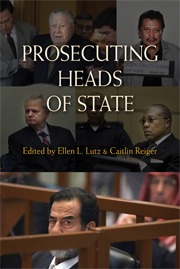Book contents
- Frontmatter
- Contents
- List of Contributors
- About the International Center for Transitional Justice
- Foreword
- Preface
- 1 Introduction
- 2 Prosecutions of Heads of State in Europe
- 3 Prosecutions of Heads of State in Latin America
- 4 The Multiple Prosecutions of Augusto Pinochet
- 5 A Leader Takes Flight: The Indictment of Alberto Fujimori
- 6 Charm and Punishment: How the Philippines' Leading Man Became Its Most Famous Prisoner
- 7 Shifting Legitimacy: The Trials of Frederick Chiluba
- 8 A Justice “Trickle-Down”: Rwanda's First Postgenocide President on Trial
- 9 Justice Squandered? The Trial of Slobodan Milošević
- 10 A Big Man in a Small Cell: Charles Taylor and the Special Court for Sierra Leone
- 11 Political Pedagogy, Baghdad Style: The Dujail Trial of Saddam Hussein
- 12 Conclusion
- APPENDIX: List of Prosecutions of Heads of State or Government since 1990
- Selected Bibliography
- Index
1 - Introduction
Published online by Cambridge University Press: 06 August 2009
- Frontmatter
- Contents
- List of Contributors
- About the International Center for Transitional Justice
- Foreword
- Preface
- 1 Introduction
- 2 Prosecutions of Heads of State in Europe
- 3 Prosecutions of Heads of State in Latin America
- 4 The Multiple Prosecutions of Augusto Pinochet
- 5 A Leader Takes Flight: The Indictment of Alberto Fujimori
- 6 Charm and Punishment: How the Philippines' Leading Man Became Its Most Famous Prisoner
- 7 Shifting Legitimacy: The Trials of Frederick Chiluba
- 8 A Justice “Trickle-Down”: Rwanda's First Postgenocide President on Trial
- 9 Justice Squandered? The Trial of Slobodan Milošević
- 10 A Big Man in a Small Cell: Charles Taylor and the Special Court for Sierra Leone
- 11 Political Pedagogy, Baghdad Style: The Dujail Trial of Saddam Hussein
- 12 Conclusion
- APPENDIX: List of Prosecutions of Heads of State or Government since 1990
- Selected Bibliography
- Index
Summary
In September 1985, nine members of Argentina's military junta, whose successive regimes covered the period in Argentine history known as the “dirty war, ” walked into a courtroom in downtown Buenos Aires. Until that day, they had absented themselves from their trial, which had already gone on for months and during which hundreds of witnesses testified about their torture, the disappearance of loved ones, arbitrary arrest, cruel detention, and even crueler methods of extrajudicial execution. The city was mesmerized by the trial. Long lines for seats in the observation gallery formed days in advance of each court session. By eight in the morning, all the copies of El Diario del Juicio, the unofficial newspaper report of the testimony of the previous day, were sold out.
Entering the courtroom, some of the generals and admirals were stone-faced. Others whispered among themselves. None displayed any signs of remorse, and only one, Lieutenant General Lami Dozo (who later was acquitted), appeared agitated. The two most notorious of the accused made the greatest impression on the gallery. Admiral Emilio Eduardo Massera, an imposing figure who had been head of the navy – which ran the Navy Mechanics School where some five thousand disappeared persons were held between 1976 and 1979 – appeared in court in full navy dress regalia. By contrast, his army cojunta member, General Jorge Videla, appeared in court in civilian clothes and refused to appoint counsel for his defense (a court-appointed defender represented him).
- Type
- Chapter
- Information
- Prosecuting Heads of State , pp. 1 - 24Publisher: Cambridge University PressPrint publication year: 2009
- 8
- Cited by



